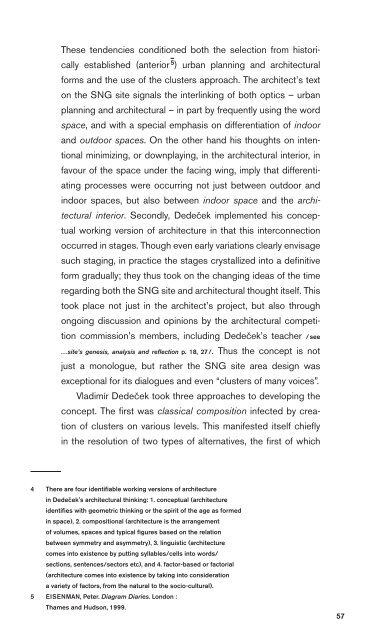sng_2016-05-12_high-single-crop_k3
You also want an ePaper? Increase the reach of your titles
YUMPU automatically turns print PDFs into web optimized ePapers that Google loves.
These tendencies conditioned both the selection from historically<br />
established (anterior 5 ) urban planning and architectural<br />
forms and the use of the clusters approach. The architect’s text<br />
on the SNG site signals the interlinking of both optics – urban<br />
planning and architectural – in part by frequently using the word<br />
space, and with a special emphasis on differentiation of indoor<br />
and outdoor spaces. On the other hand his thoughts on intentional<br />
minimizing, or downplaying, in the architectural interior, in<br />
favour of the space under the facing wing, imply that differentiating<br />
processes were occurring not just between outdoor and<br />
indoor spaces, but also between indoor space and the architectural<br />
interior. Secondly, Dedeček implemented his conceptual<br />
working version of architecture in that this interconnection<br />
occurred in stages. Though even early variations clearly envisage<br />
such staging, in practice the stages crystallized into a definitive<br />
form gradually; they thus took on the changing ideas of the time<br />
regarding both the SNG site and architectural thought itself. This<br />
took place not just in the architect’s project, but also through<br />
ongoing discussion and opinions by the architectural competition<br />
commission’s members, including Dedeček’s teacher / see<br />
…site’s genesis, analysis and reflection p. 18, 27 /. Thus the concept is not<br />
just a monologue, but rather the SNG site area design was<br />
exceptional for its dialogues and even “clusters of many voices”.<br />
Vladimír Dedeček took three approaches to developing the<br />
concept. The first was classical composition infected by creation<br />
of clusters on various levels. This manifested itself chiefly<br />
in the resolution of two types of alternatives, the first of which<br />
4 There are four identifiable working versions of architecture<br />
in Dedeček's architectural thinking: 1. conceptual (architecture<br />
identifies with geometric thinking or the spirit of the age as formed<br />
in space), 2. compositional (architecture is the arrangement<br />
of volumes, spaces and typical figures based on the relation<br />
between symmetry and asymmetry), 3. linguistic (architecture<br />
comes into existence by putting syllables/cells into words/<br />
sections, sentences/sectors etc), and 4. factor-based or factorial<br />
(architecture comes into existence by taking into consideration<br />
a variety of factors, from the natural to the socio-cultural).<br />
5 EISENMAN, Peter. Diagram Diaries. London :<br />
Thames and Hudson, 1999.<br />
57



